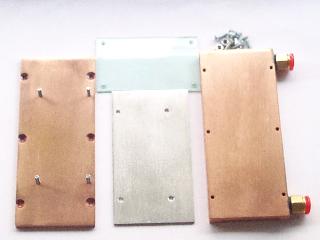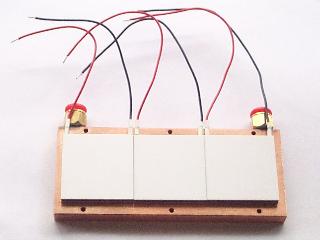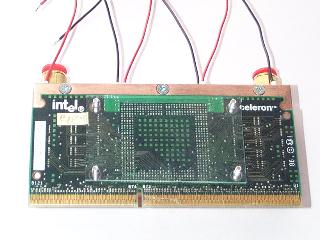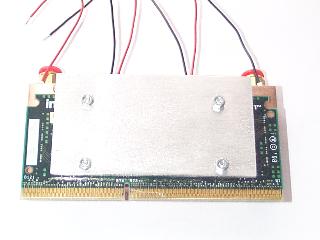Peltier on Ice 6/16/99
If you read Chen’s stuff, you quickly get the itch to dump some ice into a cooler and take a whack at some real aggressive cooling. So I did – bought a bag of ice, put some water and the ice in a cooler and rigged up the copper water-cooler with the peltier. What I did differently this time is wrap up the whole thing in plastic wrap – what this did is exclude air from the cold plate and there was no ice on the cold plate. I did find some on the plastic wrap, but would suggest that under any insulation something like plastic wrap to keep the moisture out is a good idea.
Setup
Same as below – C366, peltier at 16 volts, Chen’s copper cooler and water fountain pump but now with a cooler chest of ice and water.
Results
All setups ran Prime 95 for at least 5 minutes to do a quick stability test:
550 @ 2.3 v at rest: -4 F
550 @ 2.3 v Prime95: 42 F
567 @ 2.3 v, P95: 46 F
616 @ 2.3 v, P95: Fail.
Now let’s see how low we can get the voltage, all under Prime 95:
550 @ 2.3 v: 46 F
550 @ 2.2 v: 39 F
550 @ 2.1 v: 35 F
550 @ 2.05 v: 32 F
550 @ 2.0 v: 32 F
550 @ 1.95 v: Fail.
567 @ 2.3 v: 46 F
567 @ 2.2 v: 42 F
567 @ 2.1 v: 39 F
567 @ 2.05 V: Fail.
Remember – this is a C366 that will not post at all at 550 and normal cooling – I mean black screen.
Conclusions
You want super overclocking, you need super-cooling. Water is denser than air and can get you there, but with a fair degree of effort. Old refrigerators, dehumidifiers etc. are fair game for getting water to freezing temps. Regardless of what you are attempting, effective cooling is a key element.
The following is an email sent by Chen and details results obtained using 3 water-cooled peltiers on a Celeron 333
Chen’s Water-Cooled Peltier C333a Results
“I made a test of my all copper water-cooler’s cooling ability with three 8A peltiers powered by three stand-alone DC power supplies (8.5A/each). The water is ice water (0 C) using a fish tank filled with lots of ice and water.
M/B: ASUS P2B-F + Turbo.PLL-01
AGP: Diamond Viper V550
Sound: Diamond MX300
SCSI: AHA 2940-U2W
HDD: Quantum Viking II 4.5G, IBM DCAS 4.3G
SDRam: PC100 64M*4 HY57V658020A TC-10P chip (the chip can work up to 158MHz bus speed )
CDRom: Plextor UltraPlex 32X CDRom
CDRom Writer: Plextor 820Ti
Beginning with a no-load cooling test:
Turn on first Peltier, after 5 mins the CPU’s temp is -15 C.
Then second Peltier, after 5 mins CPU’s temp is -27 C.
Then third Peltier, after 5 mins the CPU’s temp is -35 C.
Power up PC with 5*[email protected] (BIOS shows 547MHz) every thing fine, CPU temp -29 C.
“Tune-up” the Turbo.PLL-01 to [email protected] and the system hangs up! CPU temp -28 C.
Boot up with 590 @ 2.3V; system OK! Now try to hit 620MHz, CPU temp -27 C.
Tune the PLL-01 to 620MHz; everything seems fine – CPU temp -26 C.
CPUMark99 result: 51.4.
Run Final Reality but freezes up half way – CPU temp -25 C.
Change V/core to 2.5 for 620 MHz but fails – CPU temp -24 C.
Tune the PLL-01 down to 611 and V/core to 2.3 – everything fine CPU temp -25 C.
Celeron 333 Final Results:
122.2*5=611@ 2.3V, CPU temp -25 C.
CPUMark99: 49.3
Final Reality: 2D/6.47, 3D/4.64, Bus/4.71 – Overall / 5.20
Chen
Taiwan R.O.C.”
Alpha/Peltier Update 6/15/99
As you can see from the series of updates, I have been trying all sorts of things to get this particular Celeron 366 (courtesy of PC Nut) to a stable 550. To recap, this chip will not do 550 without super-cooling. I have tried a series of experiments with air-cooled peltiers and the Alpha P125. To date, this approach has come tantalizingly close, as I can get 550, but not stable. According to Motherboard 4.07’s thermal diode monitoring, I can get the chip to around freezing but as soon as I run Prime 95 Torture Test, it fails – and the failure temp is around 75-80 degrees F. All of these tests were run at 550 and 2.3 volts.
Now a little package shows up on my doorstep today – it is a very elegant CPU water-cooler hand-made by Chen of Taiwan. If you have not followed Chen’s adventures, he is a consummate overclocker who routinely breaks barriers by using a water-cooled peltier approach. We have been reporting regularly his achievements and it turns out he is making these beauties for his overclocking brethren on Taiwan.

Now look, the only difference between the US and Taiwan is about $30 of airmail, so I asked about US availability and Chen very kindly sent me a sample to try out.
Folks, I have seen the light and it is a star from the east. I am pleased to report that I have achieved a stable 550 at 2.3 volts using Chen’s solid copper CPU water-cooler. It consists of the water jacket, a cold plate, a backing plate, a plastic piece of mysterious (to me) usage, screws and washers to build a water-cooled Celeron/peltier sandwich.
SETUP
Naturally I could not wait to try this out! I opened the package and marveled at how well made it is – very solid – weighs just under 2 pounds assembled with all components. I mean this really is solid copper – the only aluminum piece is the rear backing plate.
Now I had to get a pump and thanks to Dan (webmaster) I went to Home Depot and got a 90 GPH garden water pump (Becket Corp, Dallas TX). This is totally submersible and runs on 110 volts. Chen’s water cooler comes with ¼” OD tubing – the pump uses ½” OD tubing. What I did was to place 6″ of ½” tubing on the pump’s outlet and slide the ¼” tubing into it. It cut down the flow a little which probably did not hurt – I was concerned that the pressure would blow the small tubing off the water-cooler.
Now the way the small tubing attaches is by jamming it in tightly to the inlet and outlet ports on the water-cooler. I tested it and at first it leaked a little. I forced it in harder and it stopped; longer term I would be concerned about this type of arrangement and would prefer to see outlets that could use hose clamps instead (NOTE: Images are from Chen showing 3 peltiers – I only used one).

So I put the Ferrotec peltier on it, lightly tightened all the bolts, took it to the sink, filled it up, plunked the pump into it, hooked it up and ran it for a while. Looks OK, so on to the real stuff.

I used a small bucket, filled it half full with water and plopped a bunch of ice packs into it to keep the water cool. The pump was at the bottom of all this with the 2 ¼” tubes coming out the water-cooler into the bucket, one attached to the pump, one dumping waste water into the bucket.
I did not use any retention brackets in the Slot because I was testing the unit first. With the almost 2 pound weight, you will need a secure arrangement. I hooked up a separate power supply for the peltier, plugged in the water pump, fired up the peltier (at 15 volts) and waited to see what would happen.

RESULTS
Everything held together so I then fired up the computer. I set the voltage to 2.3 and booted into W95. I use Soft FSB simply because it is easier to manipulate various settings and jacked it up to 550 and waited.
After about 5 minutes the thermal diode registered 23 F, and I figured let’s go for it. This is 23 F with the CPU at 2.3 volts and 550.
I ran Prime 95 for about 5 minutes and the temp climbed to 64 F. The water temp stayed at 58.5 F due to the ice packs. In my air-cooled attempts, as soon as the thermal diode hit 75-80 F it would fail. Never got above 64 F. I stopped after 5 minutes because by now condensation had become a major concern. I did not put any insulation on this setup as I was testing it to see if I could hit my objective – I did and now insulation becomes the next frontier. Also no question that if I can get the water temp down, I will get lower CPU temps.
CONCLUSION
I am a skeptic. It takes a lot to convince me, which is why I so stubbornly set out to use air-cooling first. More than one person has emailed me to tell me to stop fooling with air-cooling and use water. So OK, the water-cooling folks were right – at least in this case.
My overall conclusion is that with very aggressive cooling, almost any chip can perform way above spec, and that if you have a chip “on-the-edge”, air-cooled peltiers are a reasonable next step to overclocking.
I also feel that most likely a good chip can really shine with aggressive cooling such as water-cooled peltiers and take you to where no man has gone before.
I will be talking to Chen about getting some of these units over here to experiment with – Chen tells me this setup is now drilled for Celeron, PII, P3 and there is a Socket 7 model – when I get some pricing and delivery details I’ll post it.
Many Thanks to PC Nut for lending me these chips to play with.
PS: My mind is racing on possibilities – Mission critical PC in hot environment? Run a water line to the cooler. Don’t like noisy PCs? Same idea – water line with some kind of solenoid switch, super quiet power supply (I have one from PC Power and Cooling) and you have a very quiet PC – could be used in a migraine headache ward. Don’t like water around silicon? What about oil cooling?
Alpha/Peltier Update 6/7/99
One thing I noticed in using a peltier is that the back of the Slot 1 CPU gets really cold – cold enough to condense water and therefore in need on insulation. I also reasoned that it would be good idea to run a peltier on the back and achieve a double-barreled effect.
So I proceeded to strap a rear peltier on the C366, fire it up and see what chaos we could produce. Because space is limited, I could not cool the peltier with an Alpha so I used an old AAVID 2 fan heatsink.
What I found was that it indeed produced more cooling but not in the right place. When you think of it, you have to get the maximum amount of cooling on the front, where the CPU really heats up first. As cold as the back is, it is not near enough to the CPU’s heat source to impact it that quickly. As I ran Prime 95, I noticed how rapidly the temp rose as P 95 progressed, probably rising too fast for the rear peltier to make a significant contribution.
So on to the next step – a double peltier on the front! Stay tuned.
A Tale of Two Chippies 6/3/99
It was the best of chips, it was the worst of chips.
The C366a is potentially a great overclocker – the problem is hitting 550 is not that easy, I think mainly because it is at the limits of the CPU’s capabilities. There are some who can hit 550 without aggressive cooling but the odds look like about 25% of finding one to do this out of the box.
One approach to aggressive cooling requires serious experimentation with peltiers. These electronic heat pumps are marvels of physics – no moving parts and the ability to drop temperatures 60-70 degrees. However, they are tricky – used incorrectly they can “run away” and actually generate heat rather than cooling. Successful use of peltiers requires careful attention to removing waste heat. And it is here where the marriage of Alpha heatsinks and peltiers effectively utilizes the potential of both.
PC Nut kindly lent me 2 C366s, a PPGA and Slot 1 version, to mate with Alpha/peltier heatsinks. These chips do not do 550 with normal cooling or with Alphas alone. The challenge then is to use a good peltier and see if we can get to 550.
THE SETUP
I used the following system:
ABIT BX6 rev 2.02 with thermal diode fix
IBM 10 G hard driver
Matrox G200
Ensoniq PCI sound
Umax SCIS card
3 Com lan card
128 M Samsung GH
This system is normally cooled by the KryoTech Renegade, but it is very simple to disable and use normal cooling – you disconnect the power to the unit’s fan and the fridge does not turn on.
C366 PPGA SL35S L8512086
For this I used a slotket. Because the peltier is 4 mm thick, I rubber banded the Alpha Socket 7 to the slotket as a temporary method of attachment. No doubt you can devise a more permanent arrangement but this was OK for testing.
The peltier I used for these tests was a FerroTec TE6360/127/085A module that is capable of pumping 80 watts of heat at 17 volts. At 12 volts it is pumping around 40 watts, and at 15 volts probably around 45-50 watts. You can get 15 volts out of an AT power supply by connecting the yellow wire to the red wire of the peltier and the white wire from the power supply to the peltier’s black wire. If you want to overvolt a fan, for example, use this method. I have done this with the Sunon 22 cfm fans and it runs great and probably at 25 cfm at least; these are tough units and I have run one of these for 5 days straight without any failure.
This chip will not do 550 with normal cooling – I mean black screen, no semi-boot at all. So I sandwiched the peltier between the Alpha Socket 7 and the C366, using thermal grease on all contacting surfaces. I did not place any foam around it for condensation because I was interested in seeing what was possible; condensation is a key concern and must be dealt with effectively for long-term use.
If you look at commercial peltiers, you will notice this is not addressed. These units are under powered and don’t really cool well at all because insulation is tricky; running the units close to room temperature avoids condensation problems but at the expense of cooling. DON’T WASTE YOUR MONEY ON COMMERCIAL PELTIER HEATSINKS.
PPGA C366 RESULTS
I placed the Alpha/peltier sandwich on the BX6-2 and let it fly. I use a separate AT power supply to keep the main power supply unburdened, and would urge anyone doing this to do the same. I turn on the peltier’s power first, then fire up the system. If you run the Alpha’s fans off the AT, you can pre-cool the CPU before firing up the main system. Room temperature is 77 degrees.
I went right for the gold, so I ran the C366 at 2.3 volts. I use Oda’s FSB program to change FSBs in Windows – it’s quicker when experimenting and ensures that you will boot up. The peltier at rest (with Waterfall) keeps the C366 at 46 degrees F as measured by the chip’s thermal diode.
I then went to 550 – no crash. At rest the chip is still at 46 F, understandable with Waterfall because at rest 99% of the chip is off – it is basically a piece of inert silicon. Condensation is noticeable, especially at the back of the slotket and around the edges of the socket, but not extreme as humidity is not that high yet.
I then start Prime 95 to stress the CPU and see if it will hold up. The temp starts to rise and after running Prime 95 for about 90 seconds it fails – the CPU temp is at 78 degrees. It fails but does not crash. I measure the fan’s exit temp and it is 84 F.
Figuring I need more cooling, I bump the peltier to 15 volts. Interestingly the at-rest temp is now higher – 46 F. Why? Simple, we have hit the limit of what the Alpha can effectively dump as excess heat. With the C366 at 550 and the peltier at 50 watts, the total heat load is around 90 watts – still impressive as the peltier is not running away, but still very close to the limit.
Running the C366 under Prime 95 with the peltier at 15 volts is actually worse because the Alpha can’t dump heat fast enough, so this time it freezes.
I then try a cold plate and have no real success with this. It is an aluminum piece 1/8 inch thick, but I find the thermal diode temp runs around 50 F with this setup. There is more work to be done with cold plates but not this time.
So the net result is a convincing one – this CPU will run 550 if we can get temps lower. More aggressive cooling is needed, and that means water-cooled peltiers – I will be doing some experiments with this also, so stay tuned.
SLOT 1 C366 SL37Q 08490353
PC Nut kindly provided a Slot 1 C366 also, and I used the P125 for this test with the Global Win 26 cfm fans, so we have 52 cfm pumping through the massive P125 – lots of cooling here. Mounting the peltier with the P125 is very easy – waste the back piece and aluminum spacers, use the 4 screws and finger tighten the sandwich together. Be sure to use non-conductive washers on the back of the chip – I used some rubber – just cut out a little square, punched a hole in it and used a metal washer on top of the screw and pushed it through the rubber.
Without the peltier, the Alpha cools the chip to 86 F at rest, 104 F running Prime 95. Bumping the voltage to 2.3 volts results in temps of 89 F at rest and 111 F under Prime 95. This chip runs warmer than the PPGA. Bumping up to 550 is a total NG – instant freeze.
On to the peltier – same setup – sandwich the Ferrotec between the Alpha and the C366.
Now the at-rest temp with the peltier at 12 volts is 33 F, with the fans’ exit temp at 90 F. Bumped to 550 and it runs OK. The acid test – under Prime 95 is starts but at 75 F it fails and freezes. Increased the peltier to 15 volts and now find that it runs Prime 95 for about 30 seconds and then fails at 78 F, but does not freeze. This is a clue that additional cooling edges us closer to stable running at 550.
CONCLUSIONS
After all of this I am very encouraged – I think that it is possible to overclock virtually every chip to the limits of the silicon – in this case as high as 600 MHz for Celerons. The key is temperature, and the key to aggressive cooling is peltiers and water-cooling. There are a number of articles on this site and others about what water-cooling can achieve, and we will continue this saga along these lines.
POSTSCRIPT – SLOT 1 C300a SL2WM 08460006
As an aside, I also tested my C300a (a PC Nut pre-tested chip) with the Alpha Socket 7/peltier sandwich and am pleased to report that this chip, which does not run at 504 normally, does with the peltier. The C300a at rest temp is 35 F and runs Prime 95 at 2.1 volts stable. The thermal diode reads 93 F under Prime 95. This chip will not run 526 at 2.3 volts.
I then tried the P125/peltier combo and had better results. For this series I was going for 526 so I ran all these test at 2.3 volts.
C300a Results As Follows:
450: Rest – below 32 F, Prime 95 – 84 F
504: Rest – 35 F, Prime 95 – 93 F stable
526: Rest – 37 F, Prime 95 – Fail but no crash.
I then tried 526 with the peltier at 15 volts:
526: Rest – 35 F, Prime 95 Fail at 95 F after 90 seconds
I conclude from this that the P125 is a better solution for air cooling a peltier (DUH!) given its larger size and higher cooling capacity. If you can rig this up with a Socket 7 chip, could be a winning combo.
I also feel that if you have a chip that is “on the edge” of hitting some high speeds (e.g. boots into W95/98 but freezes quickly), a peltier can be the ticket to get you there. For this particular C300a, getting to 504 stable and potentially to 526 was not achievable without the Alpha/peltier combo.



Be the first to comment